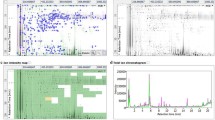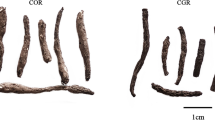Abstract
This study is intended to explore the chemical differences of Acori Tatarinowii Rhizoma (ATR) samples collected from two habitats, Sichuan and Anhui provinces, China. Gas chromatography-mass spectrometry (GC-MS) was applied to establishing the quantitative chemical fingerprints of ATRs. A total of 104 volatile compounds were identified and quantified with the information of mass spectra and retention index (RI). Furthermore, least absolute shrinkage and selection operator (LASSO), a sparse regularization method, combined with subsampling was employed to improve the classification ability of partial least squares-discriminant analysis (PLS-DA). After variable selection by LASSO, three chemical markers, β-elemene, α-selinene and α-asarone, were identified for the discrimination of ATRs from two habitats, and the total classification correct rate was increased from 82.76% to 96.55%. The proposed LASSO-PLS-DA method can serve as an efficient strategy for screening marked chemical components and geo-herbalism research of traditional Chinese medicines.
摘要
本文旨在研究中国四川和安徽2 个产地石菖蒲样品的化学差异。首先通过气相色谱-质谱联用 (GC-MS)技术建立石菖蒲的定量化学指纹图谱,基于色谱、质谱信息和保留指数定性和定量了石菖 蒲中104 种挥发性化合物。在此基础上,采用一种稀疏正则化方法来提高偏最小二乘-判别分析 (PLS-DA)模型的分类能力,使得分类精度从82.76%上升到96.55%。最后,结合最小绝对收缩与选 择算子(LASSO)与二次采样筛选出区别于2 个产地的3 个化学标记物:β-榄香烯,α-芹菜素和α-细 辛醚。本文采用的最小绝对收缩与选择算子-偏最小二乘-判别分析(LASSO-PLS-DA)算法可以作为 筛选中草药中标志性化学成分和进行地理草药学研究的有效方法。
Similar content being viewed by others
References
FENG Xiao-lin, YU Yang, QIN Da-peng, GAO Hao, YAO Xin-sheng. Acorus linnaeus: A review of traditional uses, phytochemistry and neuropharmacology [J]. RSC Advances, 2014, 5(7): 5173–5182.
NANDAKUMAR S, MENON S, SHAILAJAN S. A rapid HPLC-ESI-MS/MS method for determination of β-asarone, a potential anti-epileptic agent, in plasma after oral administration of acorus calamus extract to rats [J]. Biomedical Chromatography, 2013, 27(3): 318–326.
FENG Xiao-lin, YU Yang, GAO Hao, MU Zhen-qiang, CHENG Xiao-rui, ZHOU Wen-xia. ChemInform abstract: New sesquiterpenoids from the rhizomes of Acorus tatarinowii [J]. Cheminform, 2014, 4(79): 42071–42077.
ZANOLI P, AVALLONE R, BARALDI M. Sedative and hypothermic effects induced by β-asarone, a main component of Acorus calamus (pages S114–S116) [J]. Phytotherapy Research, 1998, 12(S1): S114–S116.
MUTHURAMAN A, SINGH N, JAGGI A. Protective effect of Acorus calamus L. in rat model of vincristine induced painful neuropathy: An evidence of anti-inflammatory and anti-oxidative activity [J]. Food & Chemical Toxicology: An International Journal Published for the British Industrial Biological Research Association, 2011, 49(10): 2557–2563.
WEI Gang, CHEN Yun-bo, CHEN Dong-feng, LAI Xiao-ping, LIU Dong-hui, DENG Ru-dong. Beta-asarone inhibits neuronal apoptosis via the CaMKII/CREB/Bcl-2 signaling pathway in an in vitro model and AbetaPP/PS1 mice [J]. Journal of Alzheimers Disease Jad, 2013, 33(3): 863–880.
LIU Lin-na, WANG Jing-jie, SHI Lei, ZHANG Wen-juan, DU Xiao-yan, WANG Zhi-peng. β-asarone induces senescence in colorectal cancer cells by inducing lamin B1 expression [J]. Phytomedicine International Journal of Phytotherapy & Phytopharmacology, 2013, 20(6): 512–520.
WEI Gang, CHEN Yun-bo, CHEN Dong-feng, LAI Xiaoping, LIU Dong-hui, DENG Ru-dong. β-asarone inhibits neuronal apoptosis via the CaMKII/CREB/Bcl-2 signaling pathway in an in vitro model and AβPP/PS1 mice [J]. Journal of Alzheimers Disease Jad, 2013, 33(3): 863–880.
YANG Yuan-xiao, CHEN Yi-tao, ZHOU Xiao-jie, HONG Chun-lan, LI Chang-yu, GUO Jian-you. Beta-asarone, a major component of Acorus tatarinowii Schott, attenuates focal cerebral ischemia induced by middle cerebral artery occlusion in rats [J]. BMC Complementary & Alternative Medicine, 2013, 13(1): 1–6.
ZHU Ting-zhun, XU Ying-hui, DONG Bin, ZHANG Jia-ning, WEI Zhen-qing, XU You-song. β-elemene inhibits proliferation of human glioblastoma cells through the activation of glia maturation factor β and induces sensitization to cisplatin [J]. Oncology Reports, 2011, 26(2): 405–413.
LIU Wen-bin, ZHANG Bing-yang, XIN Zhong-quan, REN Da-bign, YI Lun-zhao. GC-MS fingerprinting combined with chemometric methods reveals key bioactive components in Acori Tatarinowii Rhizoma [J]. International Journal of Molecular Science, 2017, 18(7): 1342.
MARRIOTT P, SHELLIE R, CORNWELL C. Gas chromatographic technologies for the analysis of essential oils [J]. Journal of Chromatography A, 2001, 936(1, 2): 1–22.
ZHANG Xiao-jun, YI Lun-zhao, DENG Bai-chuan, CHEN Lian, SHI Shu-ting, ZHUANG Yong-liang, ZHANG Yi. Discrimination of Acori Tatarinowii Rhizoma and Acori Calami Rhizoma based on quantitative gas chromatographic fingerprints and chemometric methods [J]. Journal of Separatim Science, 2015, 38(23): 4078–4085.
YI Lun-zhao, DONG Nai-ping, YUN Yong-huan, DENG Bai-chuan, REN Da-bing, LIU Shao. Chemometric methods in data processing of mass spectrometry-based metabolomics: A review [J]. Analytica Chimica Acta, 2016, 914: 17–34.
SAMPATH A, GOMATHI N. Decision tree and deep learning based probabilistic model for character recognition [J]. Journal of Central South University, 2017, 24(12): 2862–2876.
JONG S. SIMPLS: An alternative approach to partial least squares regression [J]. Chemometrics & Intelligent Laboratory Systems, 1993, 18(3): 251–263.
WOLD S, SJSTRM M, ERIKSSON L. PLS-regression: A basic tool of chemometrics [J]. Chemometrics & Intelligent Laboratory Systems, 2001, 58(2): 109–130.
FISHER R. The use of multiple measurements in taxonomic problems [J]. Annals of Human Genetics, 1936, 7(2): 179–188.
XIN Zhong-quan, ZHANG Xiao-juan, REN Da-bing, YI Zhi-biao, YI Lun-zhao. Chromatographic fingerprints combined with chemometric methods reveal the chemical features of Authentic Radix Polygalae [J]. Journal of Aoac International, 2017, 100(1): 30–37.
FU Guang-hui, ZHANG Bing-yang, KOU He-dan, YI Lun-zhao. Stable biomarker screening and classification by subsampling-based sparse regularization coupled with support vector machines in metabolomics [J]. Chemometrics and Intelligent Laboratory Systems, 2017, 160: 22–31.
WEHRENS R, FRANCESCHI P, VRHOVSEK U, MATTIVI F. Stability-based biomarker selection [J]. Analytica Chimica Acta, 2011, 705(1, 2): 15–23.
TIBSHIRANI R. Regression shrinkage and selection via the LASSO [J]. Journal of the Royal Statistical Society, 1996, 58(1): 267–288.
WESTERHUIS J A, HOEFSLOOT H C J, SMIT S, VIS D J, SMILDE A K, van VELZIN E J J, van DUIJNHOVEN J P M, van DORSTEN F A. Assessment of PLSDA cross validation [J]. Metabolomics, 2008, 4(1): 81–89.
COMMITTEE C P. Chinese pharmacopoeia [M]. Beijing: China Medical Science Press, 2015. (in Chinese)
KOV T S E. Gas-chromatographische Charakterisierung organischer Verbindungen. Teil 1: Retentionsindices aliphatischer Halogenide, Alkohole, Aldehyde und Ketone [J]. Helvetica Chimica Acta, 2004, 41(7): 1915–1932.
BABUSHOK V, LINSTROM P, ZENKEVICH I. Retention indices for frequently reported compounds of plant essential oils [J]. Journal of Physical and Chemical Reference Data, 2011, 40(4): 43101–43147.
KARIOTI A, HADJIPAVLOULITINA D, MENSAH M, FLEISCHER T C, SKALTSA H. Composition and antioxidant activity of the essential oils of Xylopia aethiopica (Dun) A. Rich. (Annonaceae) leaves, stem bark, root bark, and fresh and dried fruits, growing in Ghana [J]. Journal of Agricultural & Food Chemistry, 2004, 52(26): 8094–8098.
STASHENKO E, MARTHA C, YAJAIRA C, HERN N, REN M. HRGC/FID and HRGC/MSD analysis of the secondary metabolites obtained by different extraction methods from Lepechinia schiedeana, and in vitro evaluation of its antioxidant activity [J]. Journal of High Resolution Chromatography, 1999, 22(6): 343–349.
OGUNWANDE I, FLAMINI G, CIONI P, OMIKOREDE O, AZEEZ R, AYODELE A. Aromatic plants growing in Nigeria: Essential oil constituents of Cassia alata (Linn.) Roxb. and Helianthus annuus L [J]. Records of Natural Products, 2010, 4(4): 211–217.
SULEIMENOV Y, ATAZHANOVA G, OZEK T, DEMIRCI B, KULYJASOV A, ADEKENOV S. Essential oil composition of three species of Achillea from kazakhstan [J]. Chemistry of Natural Compounds, 2001, 37(5): 447–450.
SCRIVANTI LIDIA R, ANTON ANA M, ZYGADLO J. Essential oil composition of Bothriochloa Kuntze (Poaceae) from South America and their chemotaxonomy [J]. Biochemical Systematics & Ecology, 2009, 37(3): 206–213.
ELIAS V, SIMONEIT B, CARDOSO J. Analysis of volatile sesquiterpenoids in environmental and geological samples [J]. Journal of High Resolution Chromatography, 1997, 20(6): 305–309.
KOCSIS N, AMTMANN M, MEDNY N, KOR N. GC-MS Investigation of the aroma compounds of Hungarian red paprika (Capsicum annuum ) cultivars [J]. Journal of Food Composition & Analysis, 2002, 15(2): 195–203.
ACREE T, ARN H. Flavornet: A database of aroma compounds based on odor potency in natural products [J]. Developments in Food Science, 1998, 40(98): 27.
BASER K, DEMIRCI B, ÖZEK T, AKALIN E, ÖZHATAY N. Micro-distilled volatile compounds from ferulago species growing in western turkey [J]. Pharmaceutical Biology, 2002: 466–471.
TRESSL R, FRIESE L, FENDESACK F, KOEPPLER H. Studies of the volatile composition of hops during storage [J]. Journal of Agricultural & Food Chemistry, 2002, 26(6): 1426–1430.
SAGRERO-NIEVES L, BARTLEY J. Volatile components from the leaves of heterotheca inuloides cass [J]. Flavour & Fragrance Journal, 1996, 11(1): 49–51.
ONG P, ACREE T, LAVIN E. Characterization of volatiles in Rambutan Fruit (Nephelium lappaceum L.) [J]. Journal of Agricultural & Food Chemistry, 1998, 46(2): 611–615.
COUNET C, CALLEMIEN D, OUWERX C, COLLIN S. Use of gas chromatography-olfactometry to identify key odorant compounds in dark chocolate. Comparison of samples before and after conching [J]. Journal of Agricultural & Food Chemistry, 2002, 50(8): 2385–2391.
CHOI H. Volatile constituents of satsuma mandarins growing in Korea [J]. Flavour & Fragrance Journal, 2004, 19(5): 406–412.
HOGNADOTTIR A, ROUSEFF R. Identification of aroma active compounds in orange essence oil using gas chromatography-olfactometry and gas chromatographymass spectrometry [J]. Journal of Chromatography A, 2003, 998(1, 2): 201–211.
LE Q J, LATRASSE A. Composition of the essential oils of blackcurrant buds (Ribes nigrum L.) [J]. Journal of Agricultural & Food Chemistry, 1990, 38(1): 3–10.
SHAFAGHAT A, SADEGHI H, OJI K. Composition and antibacterial activity of essential oils from leaf, stem and root of Chrysanthemum parthenium (L.) Bernh. from Iran [J]. Natural Product Communications, 2009, 4(6): 859–860.
KILANI S, LEDAUPHIN J, BOUHLEL L, SGHAIER B, SGHAIER B, BOUBAKER J. Comparative study of cyperus rotundus essential oil by a modified GC/MS analysis method. evaluation of its antioxidant, cytotoxic, and apoptotic effects [J]. Chemistry & Biodiversity, 2008, 5(5): 729–742.
LAM K, CHEN J, LAM C, WU Q, YAO P, DONG T. Asarone from Acori Tatarinowii Rhizoma Potentiates the nerve growth factor-induced neuronal differentiation in cultured PC12 cells: A signaling mediated by protein kinase A [J]. Plos One, 2016, 11(9). DOI: 10.1371/journal.pone. 0163337.
QIU Guo-zhen, CHEN Sheng-qiang, GUO Jia-ling, WU Jie, YI Yong-hong. Alpha-asarone improves striatal cholinergic function and locomotor hyperactivity in Fmr1 knockout mice [J]. Behavioural Brain Research, 2016, 312: 212–218.
WANG G V, LI X, HUANG F, ZHAO J, DING H, CUNNINGHAM C. Antitumor effect of β-elemene in non-small-cell lung cancer cells is mediated via induction of cell cycle arrest and apoptotic cell death [J]. Cellular & Molecular Life Sciences Cmls, 2005, 62(7, 8): 881–893.
LI X, WANG G, ZHAO J, DING H, CUNNINGHAM C, CHEN F. Antiproliferative effect of β-elemene in chemoresistant ovarian carcinoma cells is mediated through arrest of the cell cycle at the G2-M phase [J]. Cellular & Molecular Life Sciences Cmls, 2005, 62(7, 8): 894–904.
YAO Yi-qun, DING Xia, JIA Yi-chang, HUANG Chuan-xin, WANG Yi-zheng, XU Ying-hui. Anti-tumor effect of β-elemene in glioblastoma cells depends on p38 MAPK activation [J]. Cancer Letters, 2008, 264(1): 127–134.
SINGH A, CHANOTIYA C, YADAV A, KALRA A. Volatiles of callicarpa macrophylla: A rich source of selinene isomers [J]. Natural Product Communications, 2010, 5(5): 269–272.
Author information
Authors and Affiliations
Corresponding author
Additional information
Foundation item: Project(21465016) supported by the National Natural Foundation of China
Rights and permissions
About this article
Cite this article
Ma, Ss., Zhang, By., Chen, L. et al. Discrimination of Acori Tatarinowii Rhizoma from two habitats based on GC-MS fingerprinting and LASSO-PLS-DA. J. Cent. South Univ. 25, 1063–1075 (2018). https://doi.org/10.1007/s11771-018-3806-8
Received:
Accepted:
Published:
Issue Date:
DOI: https://doi.org/10.1007/s11771-018-3806-8
Key words
- Acori Tatarinowii Rhizoma
- gas chromatography-mass spectrometry
- least absolute shrinkage and selection operator (LASSO)
- partial least squares-discriminant analysis




